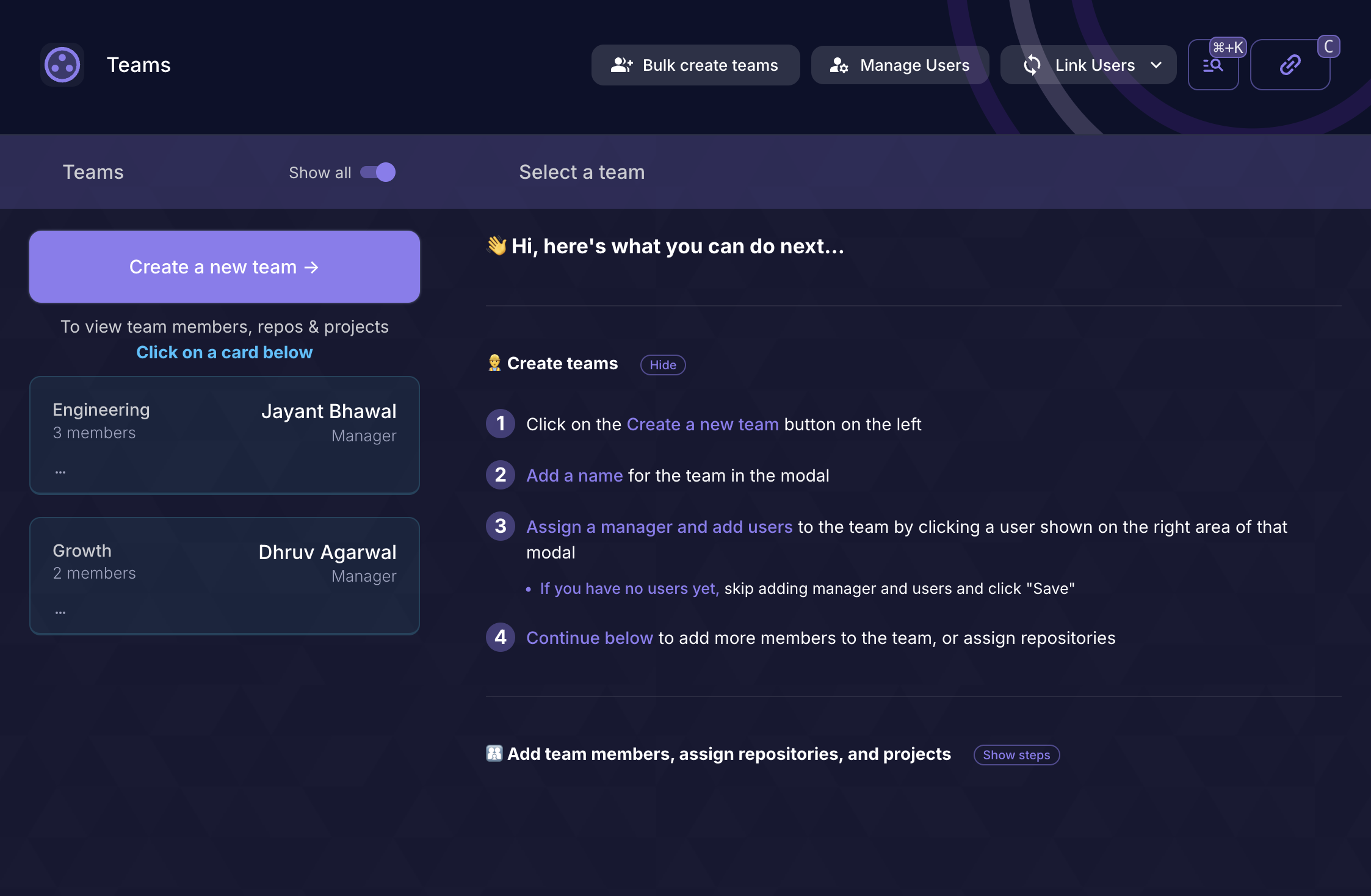Teams v1 (pre 2025)
It's a good idea to understand what Teams on Middleware are.
Read the documentation here before you continue.
Joined Middleware in 2025 (or later)? Go here.
Is this the right page for me?
If you're interested in creating multiple teams in one go, refer to this page.
If you're looking to create one team at a time, please continue...
Creating a team requires several steps (later simplified in v2)
Initial setup
- Visit https://app.middlewarehq.com/teams
- Click “Create a new team”
Click to expand image for "Create a new team"
- Specify a team name
Click to expand image for "Specify team name"
- At this point, if you have other users added to Middleware, you can select them in the right pane to add as a manager. You should find your own user here at least.
Click to expand image for "Select manager"
- If you don't find your needed user, you can skip this step for now.
- At this point, if you have other users added to Middleware, you can select them in the right pane to add as a manager. You should find your own user here at least.
- Click “Add”
Click to expand image for "Click Add"
- A team will be created, with no members, repos, projects, or incident services mappings.
Click to expand image for "Team Created"
- Next steps:
- Manager Setup
- Adding/Updating Members
- Mapping Integrations Data to Teams
- Mapping Repos
- Mapping Projects
- Mapping Incident Services
Manager Setup
If the manager is already present in Middleware
- Click the edit button on a Team card.
Click to expand image for "Edit Team Card"
- Ensure the modal says “Selecting (Manager)”
Click to expand image for "Modal for Manager Selection"
- Just click on the new manager
Click to expand image for "Select New Manager"
- Click “Save”, and you're done!
Click to expand image for "Save Manager"
If the manager is NOT present on Middleware
You can ask them to log in, and then follow these steps.
Otherwise, add them to Middleware:
- Click on “Manage Users” in the header.
Click to expand image for "Manage Users"
- Click “Add a new user” in the overlay that opens.
Click to expand image for "Add New User Overlay"
- Fill in the required fields, and click “Add”.
Click to expand image for "User Added"
- Close the overlay, such that you're back on the Teams UI again.
- Finally, follow these steps.
Adding/Updating Members
Adding members to the team
- Select the team you want to add members to. Selected teams will appear highlighted.
Click to expand image for "Select Team"
- Click this big button that says “Click to add member”
Click to expand image for "Add Member Button"
- Here, you can either search for an existing user to add to this team, or add details for a new user altogether.
If you add details for a user that might already exist, it'll simply use the existing user as long as the email is identical - without creating duplicates.Click to expand image for "Search/add user" - Clicking an existing user in the right section, or clicking “Add” will add that user to the team.
Removing members from the team
Just click the cross on the User card, from the team members list.
Mapping Integrations Data to Teams
About accesses
Middleware requires you to link various integrations to present you a full-picture scenario of your teams' planning, execution, and delivery processes.
Due to limitations in the kind of configurable access controls that many third party integrations offer, it's often not possible for us to request the limited nature of access that we actually need - which is usually only read-only access to metadata level things.
As such, actually seeing your insights on Middleware is a two step process.
- Tell Middleware which repos/projects/incident services you'll like to share data of.
- Map those selected repos/projects/incident svcs. to respective teams.
Prerequisite step before you proceed
- Visit https://app.middlewarehq.com/integrations
- Link any of your desired integrations
Click to expand image for "Link Integration"
- Most integrations would have a “Manage” button. Click that.
- You would be directed to a screen where you can select various repos/projects/incident svcs. to sync with Middleware, to subsequently map with various teams.
Mapping Repos
- Go to teams: https://app.middlewarehq.com/teams
- Click on the team you want to do this for.
- Click on the Repos tab.
- You should see a header saying “Repos linked to your org”
- Select the repos present in that section by clicking on the “<<” icon.
Here's a visual example, explaining the order of clicks:
Mapping Projects
- Go to teams: https://app.middlewarehq.com/teams
- Click on the team you want to do this for.
- Click on the Projects tab.
- You should see a header saying “Projects linked to your org”
- Select the projects present in that section by clicking on the “<<” icon.
Here's a visual example, explaining the order of clicks:
Mapping Incident Services
- Go to teams: https://app.middlewarehq.com/teams
- Click on the team you want to do this for.
- Click on the Incident Services tab.
- You should see a header saying “Services linked to your org”
- Select the services present in that section by clicking on the “<<” icon.
Here's a visual example, explaining the order of clicks:
What's next?
If you've added members to your teams, there's one more thing to do before you can see their dev-specific insights.
Go to “Linking Users” documentation for details.
Else you can just wait for 5-10 minutes for your data to be ready, and then see your team or org-level insights on any of the other analytics screens.
